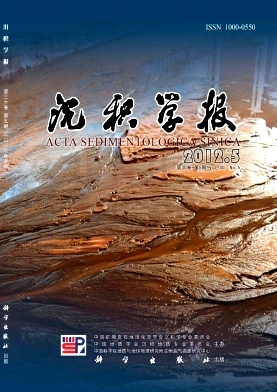Microfacies and Environment Analysis of the CarboniferousCarbonates in JiangyouGuangyuan Area, Sichuan Province
- Publish Date: 2012-10-10
-
Key words:
- microfacies combination /
- depositional environment
Abstract: The JiangyouGuangyuan area, which is located in the north margin of the Longmen Mountain Nappe Structural Belts, is one of the classic areas for the upper Carboniferous researches in Sichuan Basin and even in the upper Yangtze Plate. The upper Carboniferous was deposited in semienclosed gulfs of the western Yangtze Block, which characterized by slight thickness, light color, many fossils and several fuchsia mudstone and containing gravels bioclastic limestone as a set of semirestricted platform and open platform carbonate rocks in this area. The strata are revised according to sedimentary types, sedimentary structures, lithological characters, and paleontological combinations. The upper Zongchanggou Formation, which was considered as one part of the lower Carboniferous, is amended to the upper Carboniferous Huanglong Formation in this paper. The upper Carboniferous is divided into four parts, as lower Huanglong Formation, middle Huanglong Formation, upper Huanglong Formation and lower Chuanshan Formation.Fifteen microfacies can be divided according to field observation, laboratory microanalysis and classification of carbonate rocks by Dunham, as Unfossiliferous mudstones (MF11), Clastizoic mudstones (MF12), Calcareous green algae wackestones (MF21), Bioclastic wackestones (MF22), BirdseyesFenestral pelletoid packstones (MF3), Bivalve wackestones (MF41), Bivalve packstones (MF42), Calcareous green algae packstones (MF51), Fusulinid packstones (MF52), Bioclastic wackestones with oncoids (MF53), Bioclastic wackestones (MF54), Fine-grained peloid grainstones (MF6), Bioclastic grainstones (MF71), Fusulinid grainstones (MF72), Worn foraminiferal grainstones (MF73), Coated bioclastic grainstones (MF8), Bahamite peloids grainstones (MF91), BioclasticBahamite peloids grainstones (MF92), Ooid grainstones with radial ooids(MF101), Ooid grainstones with micritizatal concentric ooids (MF102), Lithoclasts grainstones with micrite ooids (MF11), BioclasticOncoid grainstones (MF121), Oncoid grainstones (MF122), Aggregategrain grainstones (MF13), Conglomerates grainstones (MF14), Crystal powder secondary dolomites (MF151) and Fine secondary dolomites (MF152). Based on these microfacies in the features of the vertical and horizontal combination , four sedimentary facies belts can be summarized according to the microfacies combination as winnowed platform edge sands (FZ6), open platforms (FZ7), restricted platforms (FZ8) and platform evaporates (FZ9). The combination characteristics of the depositional facies belts indicate that several transgression to regression occurred during the late Carboniferous and the maximum transgression occurred the late Huanglong Formation with Carbonate deposit in the northwest Sichuan and eastern Sichuan. 〖JP〗The studied special layer in JiangyouGuangyuan area have shown that four storm layers and storm sedimentary combinations are formed in the upper shelf environment as proximal storms rocks in Huanglong Formation, such as storm shell limestones, storm calcirudites, storm nodular limestones, storm calcarenites, scouring structures, graded beddings, knottylike structures, scale beddings, horizontal beddings, current beddings, bioturbate structures and so on.ICPMS is used to determine REE contents of oncolite carbonate rocks of the Chuanshan Formatiom in these area. The analyses of the REEs are related to their depositional environments, especially ΣREE, LREE, HREE, δCe, δEu and Y/Ho are displayed regularly. The LREE patterns are a little rightward heeling, and the HREE patterns are flat. δCe vary from 0.43 to 0.74, and the average of all samples is 0.59. They all have obviously negative δCe anomalies, as indicated strong Oxidation environments during the Chuanshan Stage. Some samples have negative δEu anomalies and some have positive δEu anomalies. As indicate that REE characteristics are affected by ancient climate cycles (glacialinterglacial cycle) and the periodical sea level changes in the Late Carboniferous.
| Citation: | Microfacies and Environment Analysis of the CarboniferousCarbonates in JiangyouGuangyuan Area, Sichuan Province[J]. Acta Sedimentologica Sinica, 2012, 30(5): 834-846. |






 DownLoad:
DownLoad: